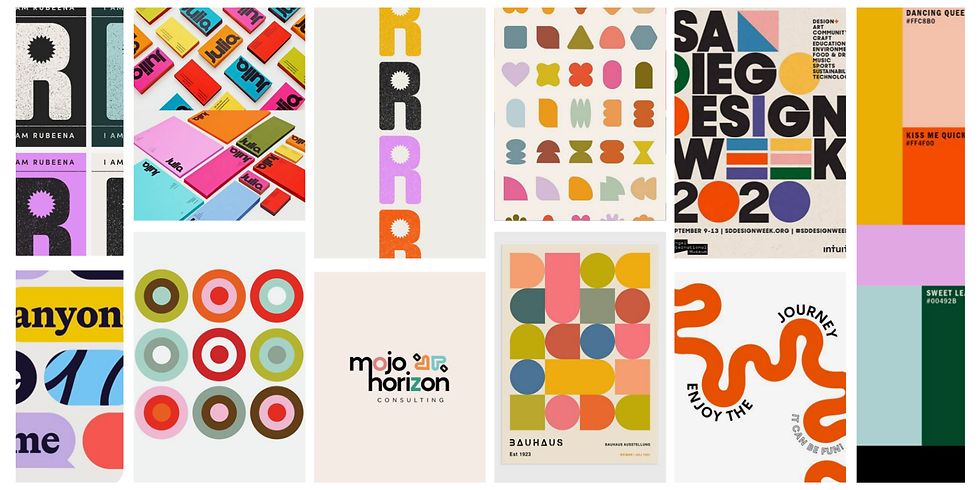Create Your Own Brand Mood Board: set the vibe for your brand
- karendbennett21
- Oct 9
- 4 min read

When you’re building a brand, it’s not just about the logos or the colours - it’s about the feeling your business creates. A mood board is a powerful way to capture that feeling in one place, so you can stay aligned with your vision. It sets the tone for your entire brand experience. That's why, as a designer, creating a mood board is one of the first steps in my process when working with clients. Even if you're not a designer, I promise it's helpful to do create a mood board to feel confident and grounded in your brand.
Create your own brand mood board in Canva - my 5 step guide
You don't need to be a designer or use fancy tools to create your first brand mood board. Follow these 5 steps and you're there.
1. Nail your brand values and customer persona(s)
Your mood board should represent what your brand stands for and what will appeal to your dream customer or client.
Think about what 3 words sum up your brand? Note these down for using in your research.
Think about your target client and what matters to them based on factors such as age, gender, occupation, hobbies, culture, where they hang out IRL and digitally and specific tastes (including design styles).
Tip - check out my Create Your Own Brand Blueprint free resource and my blog here to help with working all of this stuff out 😉
2. Gather Your Inspiration
Start with a folder where you collect anything that you feel aligns with your brand’s vibe.
Note: this could be a physical or digital folder, but bear in mind it will need to go digital at the next step.
Your folder could include:
Photos you’ve taken yourself - you might have some already on your camera roll or take some based on ideas you have (nature, interiors, images gathered from magazines)
Images from Pinterest, Canva, Google, Instagram, Unsplash or Pexels (last two are free stock image websites) - this can be a mix of photography or graphics/vectors
Look for images that reflect your values and the feeling you want people to associate with your business. You can include typography styles, colour swatches, textures, patterns, artwork or other logos. Don’t overthink - if it feels right, save it.
2. Notice the Themes
Once you’ve gathered a good selection (10–20 images is plenty), take a step back. What patterns do you see?
Are the colours warm and earthy, or cool and fresh?
Do you notice a preference for natural textures, sleek minimalism, or bold graphics?
Is there a certain mood - calm, playful, professional, or luxurious - that comes through?
These recurring elements are the heart of your brand’s visual identity.
3. Open Canva and Choose a Layout
If you don't have a Canva account, you'll need to set a one up - you can go free or Pro for added features - find out more in my blog article here. Then search 'Mood Board' in the template library. Pick one that feels simple and lets your images shine. You don’t need anything super complicated - a grid with 6–8 spaces should be perfect.
4. Upload and Curate
Upload your chosen images into Canva and start placing them into the template, dragging and dropping them into the frames. Move things around until you find a balance that feels right.
Think about:
Colour flow - do the shades sit well together?
Balance - is there a mix of close-up detail and wider imagery?
Focus - does the overall board clearly express your brand’s vibe?
Try not to overthink it and trust your instincts!
5. Add Text or Colour Swatches (Optional)
If you’d like, add a few words that represent your brand values (e.g. authentic, calm, connected), or drop in colour blocks that highlight your brand palette. This step isn’t essential but can help make your mood board even more practical and reinforce the feelings you want to evoke.
What next?
Creating a brand mood board is more than a design exercise - it’s a way of visually grounding your business in a way that feels authentic to you. When you take the time to curate your own images and build it yourself, you’re not just making something pretty. You’re creating a tool that reflects your values, your energy, and the unique story you’re telling and it's something you can use for your brand messaging and visual identity.
I'd encourage you download your mood board (as a PDF or PNG), and keep it somewhere visible, like on your desktop, printed near your workspace. If you have others working with you on you marketing, you should also share it with them. It will act as a guide for everything from your social media visuals to your website and other touch points.
Thinking about a mood board is a great start to building your brand, but I understand that you might not have the time or motivation to do it alone. Or maybe you've created your mood board, but need to translate this into actual design. If you want to explore the art of the possible, go much deeper and discover the soul in your brand, have a look at my design services or get in touch to create a brand for your business that you can be proud of.
Images below captured from Pinterest, Canva and Google





Comments